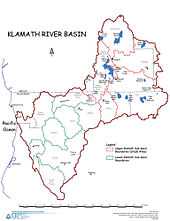Scott River
| Scott River (Beaver River) | |
| stream | |
| Country | United States |
|---|---|
| State | California |
| Region | Siskiyou County |
| Source | Confluence of South Fork Scott River and East Fork Scott River |
| - location | Callahan, California |
| - elevation | 3,120 ft (951 m) |
| - coordinates | 41°18′45″N 122°48′12″W / 41.31250°N 122.80333°W [1] |
| Mouth | Confluence with the Klamath River |
| - elevation | 1,460 ft (445 m) [1] |
| - coordinates | 41°46′44″N 123°02′06″W / 41.77889°N 123.03500°W [1] |
| Length | 60 mi (97 km) |
| Basin | 804 sq mi (2,082 km2) [2] |
| Discharge | for near Fort Jones |
| - average | 627 cu ft/s (18 m3/s) [3] |
| - max | 54,600 cu ft/s (1,546 m3/s) |
| - min | 3.4 cu ft/s (0 m3/s) |
The Scott River is a 60-mile-long (97 km)[4] river in Siskiyou County, California, United States. It is a tributary of the Klamath River, one of the largest rivers in California.
Historically, fur trappers called the river the Beaver River, before the Hudson's Bay Company nearly extirpated beaver from the area in the early 19th century.[1][5] Scott Valley was first entered by Stephen Meek, Thomas McKay, George Adolphus Duzel and 16 other Hudson's Bay trappers in 1836. In 1850 alone, Meek reportedly trapped 1,800 beaver in Scott Valley, which was then known as Beaver Valley.[6] Meek, who had hunted all over the West, declared the Beaver Valley one of the best places he had ever seen to trap beaver and hunt game, and returned to retire there at the Josiah Doll ranch from 1871 until his death in 1889 at the age of 90.[7] The 1850 discovery of gold during the California Gold Rush by pioneer John W. Scott at Scott Bar, downriver from Scott Valley, brought many prospectors into the area; Scott's discovery led to the naming of the valley and the river in his honor.
The Scott River's watershed covers about 800 square miles (2,100 km2). About two-thirds of the land is privately owned and about one-third is publicly owned. About 45 percent of the land is used for forestry, grazing for 40 percent, 13 percent for cropland and the remaining 2 percent of land is used for various purposes.
Dredges that operated in the Scott Valley between 1934-1950 did some of the most visible damage done during the mining era. Large Yuba dredges, which also used mercury to process sand and gravel, excavated material 50–60 feet below the river channel and flood plains and created piles of tailings more than 25 feet (7.6 m) high downstream of the town of Callahan.[8]
See also
References
- ↑ 1.0 1.1 1.2 1.3 U.S. Geological Survey Geographic Names Information System: Scott River
- ↑ "USGS Gage #11519500 on the Scott River near Scott Bar, CA". National Water Information System. U.S. Geological Survey. 1911–1913. Retrieved 2013-11-02.
- ↑ "USGS Gage #11519500 on the Scott River near Fort Jones, CA". National Water Information System. U.S. Geological Survey. 1941–2012. Retrieved 2013-11-02.
- ↑ U.S. Geological Survey. National Hydrography Dataset high-resolution flowline data. The National Map, accessed March 9, 2011
- ↑ Erwin G. Gudde, William Bright (2004). California Place Names:The Origin and Etymology of Current Geographical Names. University of California Press. p. 30. Retrieved Jan 23, 2010.
- ↑ Will Harling (2010-11-16). "Restoring Coho Salmon in the Klamath River, One Beaver At A Time". Forest and River News. Retrieved 2010-02-17.
- ↑ Gail L. Fiorini-Jenner, Monica Jae Hall (2002). Western Siskiyou County: Gold and Dreams. Arcadia Publishing. p. 8. ISBN 978-0-7385-2397-2. Retrieved May 18, 2010.
- ↑ Sabrina Litton (Spring 2003). "A Review of the History of Water Use throughout the Klamath River Basin". Center for Watershed Sciences. University of California Davis. Retrieved 2010-05-19.
External links
| |||||||||||||||||||||||||
